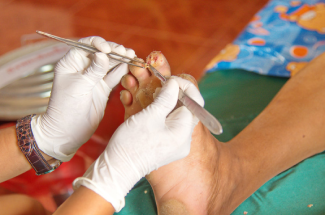Wound Care, Then and Now: A Brief History of the Evolution of Wound Care
November 4, 2021
By Emily Greenstein, APRN, CNP, CWON, FACCWS
Editor's note: This blog by Emily Greenstein, APRN, CNP, CWON, FACCWS, is the recipient of the 2022 Blog of the Year Award. It has received the most views of any blog posted on WoundSource within the last year. The WoundSource Editors would like to congratulate Emily on her award.
Historical Overview
Wound care has evolved from treatments based on superstition to systematic, evidence-based care. The history of wound healing dates back to 2000 BCE. Various civilizations over the centuries had differing approaches to wound care:
- The oldest medical manuscript, a clay tablet, describes three healing principles: washing the wounds, making the plasters, and bandaging.1
- The ancient Egyptians applied a paste of honey, grease, and lint into an open wound to remove skin and pus and encourage wound healing.2 The making of plasters or pastes is equivalent to today’s topical dressings.
- The ancient Greeks focused more on cleanliness and washed wounds with clean water, vinegar, or wine. The Hippocratic Collection states, “For an obstinate ulcer, sweet wine, and many patients should be enough.”1
- The ancient Romans were the first to describe the four cardinal signs of inflammation: “rubor, tumor, calor, et dolor,” meaning redness, swelling, heat, and pain.
- In the Middle Ages, the customary practice was to allow a wound to “rot a bit.”2
- Also during the Middle Ages, nursing tasks were mostly carried out by nuns. In 1633, the Company of the Daughters of Charity of Saint Vincent, a religious order, was founded in Paris, France with a mission to serve the sick.3
- Napoleon’s surgeon, Dominique Jean Larrey, was the first physician to document the necessity for early amputation for any limb injury in which the limb could not be saved, by noting that early amputation would create a relatively clean and viable wound.4
- The involvement of nursing in wound care has evolved from simple dressing changes to a board certified specialty.
Florence Nightingale’s Holistic Nursing
In 1854, during the Crimean War, British nurse Florence Nightingale believed that cleanliness, fresh air, quietness, good nutrition, and effectively performed treatments would drastically improve the care of the sick and injured.5 Nightingale’s practices can be applied to wound care patients. Cleanliness of the wound and the patient’s environment, education on treatments, and making sure the patient has good nutrition all help to promote good patient outcomes. Nightingale is recognized as the founder of modern nursing.
Lister Antiseptic System
In 1860, Joseph Lister published a report on the treatment of compound fractures with carbolic acid, a method known as the Lister Antiseptic System.6 Lister is also credited with the development of the first wet-to-dry dressing. In the mid-1800s, he used clean cotton batting soaked in carbolic acid to pack wounds.7 In 1890, Robert Wood Johnson, co-founder of Johnson & Johnson, began using the Lister Antiseptic System to develop gauze and wound dressings sterilized with dry heat, steam, and pressure.4
Early Formal Nursing Training
In 1873, after the American Civil War, the Bellevue Hospital’s Training School for Nurses in New York City was established. Early training involved basic cleanliness, neatness, and attending to patient comfort.8 Until the late 1800s, however, nursing duties in general focused more on domestic tasks, such as washing dishes, feeding patients, and sweeping floors.9
Wound Cleansing and Debridement
In the 1880s, textbooks on wound care began to stress the importance of skin cleansing and removal of foreign matter. Dr. Carl Reyher, a Russian military surgeon, was the first to recommend adding more extensive mechanical wound cleansing, which he termed “debridement.”7
Wound Care and Nursing in the World War I Era
From 1909 to 1918, before and during World War I (WWI), it was common practice to apply dry gauze packed with salt to the wound bed. Toward the end of WWI, the Carrel-Dakin method of continuously infusing hypochlorite solution directly into gauze packed into the wound became a standard treatment in the British Army.7 Nurses during this time were both formally trained and volunteers. Frontline wound care provided by nurses focused mainly on packing and tightly bandaging wounds before injured soldiers were transported to a hospital.10
Evolution of Metallic Antiseptics
In the late 19th century, metallic antiseptics were introduced. Silver ceramic powder was introduced in 1928, and the latest silver preparation of silver sulfadiazine became available in 1958.11 These preparations were used widely to treat Pseudomonas infection in burns. In 1974, the local application of zinc to wounds was claimed to promote healing in zinc-deficient individuals. This led to the development of Unna’s zinc sulfate paste, which is still used today in the treatment of chronic leg ulcers.11 The development of these antiseptics and the introduction of antibiotics helped decrease mortality rates and control infections.1
Moist Wound Healing
The 20th century brought about numerous changes in how we treat wounds. In the 1960s, George Winter12 and Cameron Hinman and Howard Maibach13 reported on the superior efficacy of a moist wound healing technique. This discovery led to a focus on creating and maintaining a moist wound healing environment through the use of specialized dressings.
Wound Nursing as a Specialty
The first formal specialty of wound nursing, which was referred to as enterostomal nursing, was established in 1958 at the Cleveland Clinic, but board certification did not become available until 1980.14
Wound Care Today
Now, in the 21st century, wound care involves promoting healing, preventing infections, and controlling underlying or contributing factors. Deciding on the treatment is individualized based on the type of wound, the patient’s comorbidities, and the patient or caregiver's ability to change the dressing. Wound care is evolving to much more than just a dressing change. Wound care research is expanding to new topical solutions, bioengineered tissues, and gene therapy.6
Conclusion
Wound care has been around since the beginning of humankind. Some treatments have evolved over time as more has been learned about bacteria, antiseptics, and how the human body works. However, some of the basics remain true today—cleansing a wound, preventing infection, and maintaining a moist wound healing environment.
References
1. A Brief History of Wound Healing. Ortho-McNeil Pharmaceuticals and Janssen-Cilog; 1998.
2. Henry G, Garner W. Inflammatory mediators in wound healing. Surg Clin North Am. 2003;83:483.
3. McNeil B. The Vincentian Family Tree: A Genealogical Study. Vincentian Studies Institute; 1996.
4. Attinger C, Broughton G, Janis J. A brief history of wound care. Plast Reconstr Surg. 2006;117(7 suppl):6S-11S.
5. Hegge M. Nightingale’s environmental theory. Nurs Sci Q. 2013;26(3):211-219.
6. Barr J, Brocke T. The history of wound healing. Surg Clin North Am. 2020;100(4):787-806.
7. Helling T, McNabney W. The role of amputation in the management of battlefield casualties: a history of two millennia. J Trauma. 2000;49:930.
8. Bradley-Sanders C. Bellevue School of Nursing: Lillian & Clarence De La Chapelle Medical Archives. 2009. Accessed October 27, 2021. https://archives.med.nyu.edu/collections/bellevue-school-nursing
9. American Association for the History of Nursing. The history of nursing. American Association for the History of Nursing, Inc.; 2018. Accessed October 27 2021. https://www.aahn.org/trainingcirca1884.html
10. Adie K. World War One: the many battles faced by WW1’s nurses. BBC News. 2014. Accessed October 27, 2021. https://www.bbc.com/news/magazine-26838077
11. Caldwell M. Topical wound therapy, a historical perspective. J Trauma. 1990;30(12 suppl):S116-22S.
12. Winter G. Effect of air exposure and occlusion on experimental human skin wounds. Nature. 1963;200:378-379.
13. Hinman C, Maibach H. Effect of air exposure and occlusion on experimental human skin wounds. Nature. 1963;200:377-378.
14. Anderson F. History of enterostomal therapy. In: Broadwell D, Jackson B, eds. Principles of Ostomy Care. Mosby; 1982:14-15.
About the Author
Emily Greenstein, APRN, CNP, CWON, FACCWS is a Certified Nurse Practitioner at Sanford Health in Fargo, ND. She received her BSN from Jamestown College and her MSN from Maryville University. She is certified as an Adult-Gerontology Nurse Practitioner through the American Academy of Nurse Practitioners. She has been certified in wound and ostomy care through the WOCNCB for the past 8 years. At Sanford she oversees the outpatient wound care program, serves as chair for the SVAT committee and is involved in many different research projects. She is an active member of the AAWC and currently serves as co-chair for the Research Task Force and Membership Committee. She is also a working member of the AAWC International Consolidated Diabetic Ulcer Guidelines Task Force. She has been involved with other wound organizations and currently serves as the Professional Practice Chair for the North Central Region Wound, Ostomy, and Continence Society. Emily has served as an expert reviewer for the WOCN Society and the Journal for WOCN. Her main career focus is on the advancement of wound care through evidence-based research.
The views and opinions expressed in this blog are solely those of the author, and do not represent the views of WoundSource, HMP Global, its affiliates, or subsidiary companies.












Follow WoundSource
Tweets by WoundSource